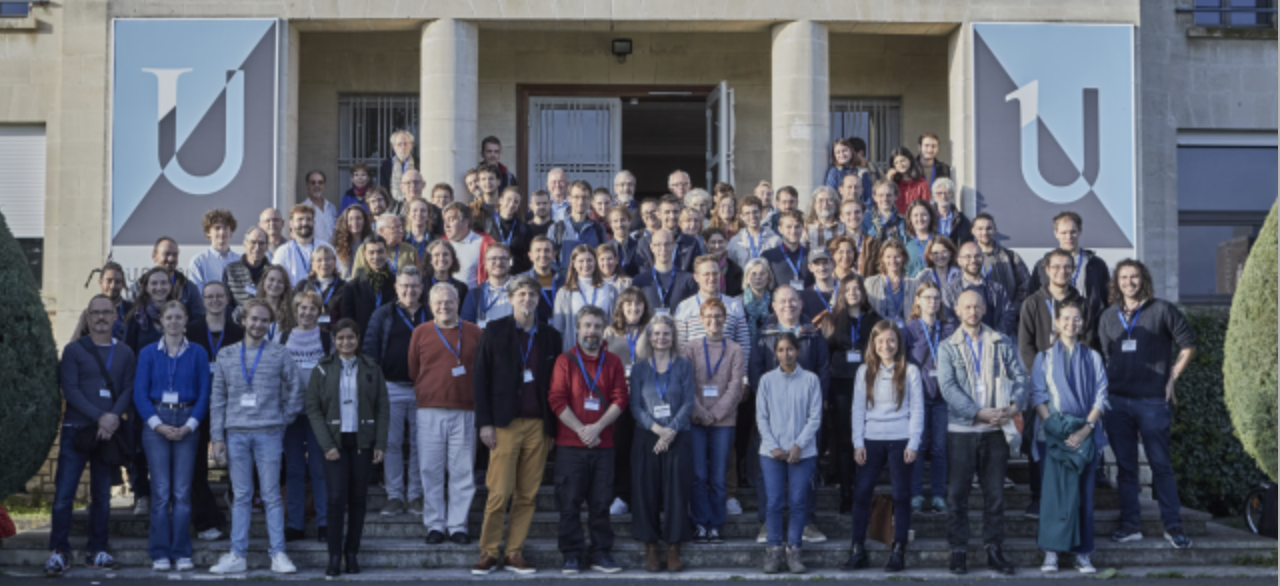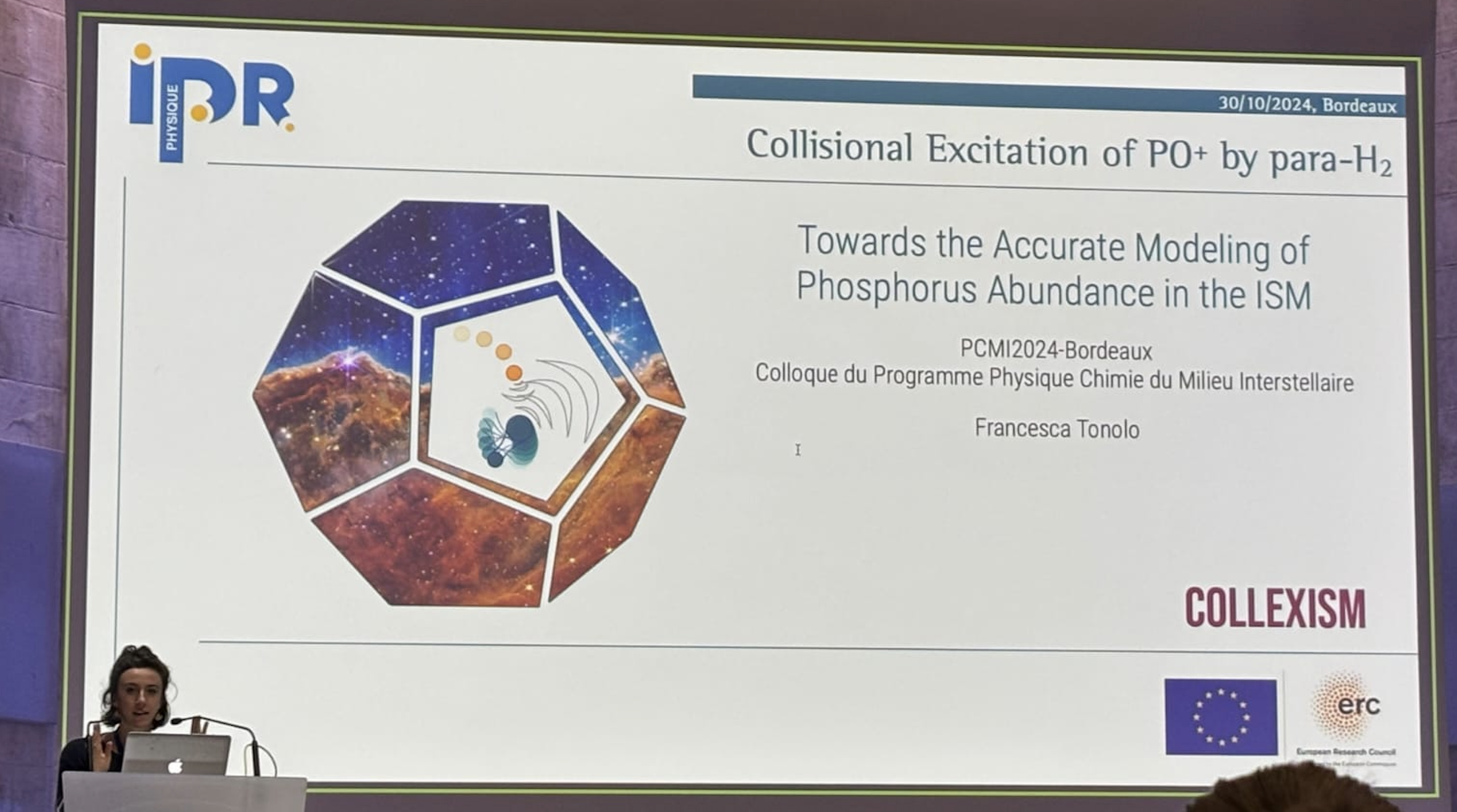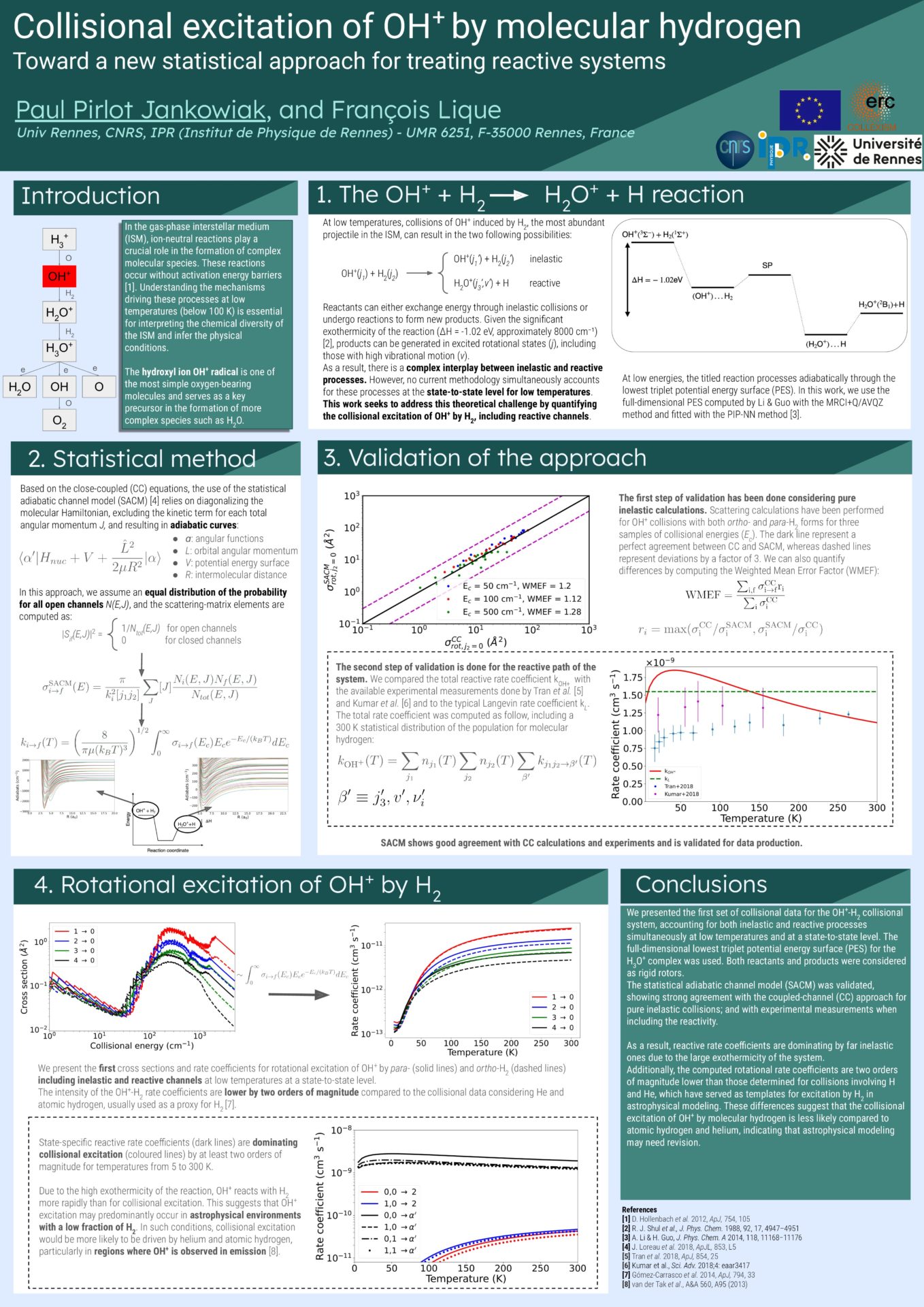by Amélie Godard Palluet & Paul Pirlot Jankowiak & Sándor Demes, on
Presentation of the conference

The biennial conference of the National Program "Physics and Chemistry of the Interstellar Medium" (PCMI) was held from October 28th to 31st in Bordeaux.
The PCMI National Program is a CNRS/INSU project-based program also supported by CNRS Physique, CNRS Chimie, CNES and CEA. It animates research between physicists, chemists and astrophysicists to progress in the understanding of the interstellar and circumstellar environments of our galaxy and other galaxies.
Three major questions motivate the program:
(1) the formation of large interstellar structures and their link to star and planet formation,
(2) the role of the interstellar medium in the evolution of our galaxy and nearby and distant galaxies, and
(3) the role of the cycling of matter between phases in the growth of molecular complexity
During this conference, F. Tonolo and S. Demes presented their work in an oral presentation.
A. Godard Palluet and P. Pirlot Jankowiak also presented their research in a poster communication.
F. Lique attended to the conference as a member of the scientific council of the PCMI.
Towards non-LTE modelling of large interstellar cyclic species: the collisional excitation of cyclopentadiene - S. Demes, F. Lique, C. T. Bop, M. B. Khalifa, J. Cernicharo and M. Agúndez
Recent astronomical observations revealed an increasing molecular complexity in the interstellar medium (ISM) through the detection of a series of large aromatic and other cyclic species [1]. To correctly interpret these detections, a complex analysis is often needed, which takes into account the non-local thermodynamic equilibrium (non-LTE) effects of the media. This requires proper state-to-state collisional data for the excitation and de-excitation of the molecular levels, since their population is mainly governed by a competition between collisional and radiative processes in such environments.
Cyclopentadiene (c-C5H6), has been recently detected in multiple interstellar sources [2], while there are no collisional data reported yet for this species. We first provide an accurate 3-dimensional potential energy surface for the interaction of c-C5H6 with helium, calculated from high-level ab initio theories, which allowed to study their collisional dynamics by the close coupling (CC) quantum scattering method [3]. To the best of our knowledge, this is the first study where the exact CC method has been applied to treat the state-to-state
rotational excitation of species involving more than ten atoms. In addition to rotational excitation cross sections, we will also present thermal rate coefficients up to 50 K kinetic temperatures, which cover all transitions between rotational levels with an internal energy of ≤ 100 cm-1. We will demonstrate the impact of accurate collisional data on radiative transfer modelling of cyclopentadiene emission lines, which provides crucial information on the physical and chemical conditions of the environment. It will also provide the appropriate critical densities, where LTE conditions are fulfilled and, finally, more reliable constrains on the relative abundance of large carbon cycles in space.
References
[1] B. A. McGuire. ApJS 2022, 259, 30.
[2] J. Cernicharo, M. Agúndez et al. A&A 2021, 649, L15, ibid 2023, 677, L13.
[3] S. Demes, C.T. Bop, M.B. Khalifa and F. Lique. Phys. Chem. Chem. Phys. 2024 (submitted).

Collisional excitation of PO+ by para-H2: Towards the accurate modeling of phosphorus abundance in the ISM - F. Tonolo, L. Bizzocchi, V. M. Rivilla, F. Lique, M. Melosso, C. Puzzarini

When looking to the astrophysical networks of interest from a prebiotic point of view, phosphorus chemistry deserves a special attention. Phosphorus is widely present in many terrestrial biomolecules and has also been discovered in various extraterrestrial environments such as planetary atmospheres, meteorites or comets. However, the understanding of phosphorus chemistry in the interstellar medium (ISM) remains limited despite extensive searches, with only a few P-bearing molecules having been identified therein, and with constrained distributions. Consequently, there is a clear need for a comprehensive study of phosphorus chemistry in the ISM. However, the extreme conditions in these environments prevent the application of the local thermodynamic equilibrium (LTE) approximation, highlighting the need for collisional rate coefficients to accurately describe molecular excitation processes. In line with this, the recent discovery of PO+ in the G+0.693-0.027 molecular cloud [1] has prompted a collisional investigation of this ion to support the interpretation and modeling of current and future observations in the ISM.
To meet the astrophysical requirements, the collision between PO+ and para-H2 was thus examined [2]. The interaction potential energy surface (PES) was accurately characterized at the CCSD(T)-F12/aug-cc-pV(Q+d)Z level of theory, and the potential was then fitted as an expansion over angular functions. The impact of rotational states of H2 on the cross-sections was found to be negligible, allowing for simplified scattering calculations which used the spherical approximation of the potential averaged over different orientations of H2. State-to-state collisional coefficients were then derived for the twenty lowest rotational levels of PO+ at temperatures ranging from 5 to 200K. The significant discrepancies between these new collisional coefficients and those obtained for the PO+ and He collisional system called into question the reliability of using He as a proxy of H2 in simulating the collisional behavior of PO+ in astrophysical contexts.
These newly obtained collisional data allowed for testing the validity of the LTE approximation and helped to refine the H2 density and column density estimation of PO+ based on the observations of the G+0.693-0.027 molecular cloud. Additionally, radiative transfer calculations indicated maser behavior for the first rotational transitions of PO+ at various kinetic temperatures and densities typically found in interstellar sources. This emphasizes the importance of accurate collisional coefficients for precise modeling of the abundance of PO+ in the ISM.
How Rate Coefficients Contribute to Investigating the Chemistry of Sulfur in the ISM - A. Godard Palluet, F. Lique, R. Fuentetaja, M. Agúndez, and J. Cernicharo
Although the chemistry of sulfur in the dense ISM has been extensively studied, a puzzling issue known as the sulfur depletion problem persists [1]. To better understand this issue, the careful determination of the abundance of sulfur-bearing species in molecular clouds must be considered.
As astrophysical media often do not fulfill the Local Thermodynamic Equilibrium (LTE) conditions, the determination of molecular abundances from molecular spectra relies on radiative transfer models. These models require collisional rate coefficients, which, unfortunately, are available for only a fraction of the molecules detected so far.
I will present our research on CCS, a ubiquitous and abundant molecule in the interstellar medium [2-4]. Several CCS isotopologues, including 13CCS and C13CS, have been detected in TMC-1, revealing an anomaly: C13CS is approximately four times more abundant 13CCS [5], which chemical models struggle to reproduce [6,7]. This anomaly can be explained either by the chemistry of this molecule or by an incorrect estimation of their respective abundances.
To investigate these hypotheses, we computed the collisional data for both 13CCS and C13CS, accounting for their hyperfine structure. Consequently, the abundances of both isotopologues in TMC-1 have been revised, offering new insights into CCS formation pathway.
Références
[1] Ruffle, D. P., et al., MNRAS 306, 691 (1999)
[2] Saito S., et al., ApJ 317 L115 (1987)
[3] Suzuki H., et al., ApJ 392 551 (1992)
[4] Cernicharo J., et al., A&A 181, L9 (1987)
[5] Sakai S., et al., ApJ 663, 1174 (2007)
[6] Furuya K., et al., ApJ 731, 38 (2011)
[7] Loison J.-C., et al., MNRAS 498, 4663 (2020)

Collisional excitation of OH+ by molecular hydrogen: Toward modeling reactive systems in cold ISM - P. Pirlot Jankowiak, and F. Lique

The modeling and interpretation of molecular spectra from interstellar environments require the knowledge of both radiative and collisional processes of energy transfer between chemical species. Accurate state-to-state rate coefficients of interstellar molecules in collision with the main collisional partners H2, H and He are then necessary [1].
The OH+ radical is key specie in the oxygen chemistry of dark molecular clouds and is an important tracer of the cosmic-ray ionization rate [2]. However, this molecule is very reactive especially by collisions with H2. Theoretical studies about collisional excitation in reactive systems is still a topic of ongoing exploration. Especially for exothermic and barrier-less reactions, a competition between reactivity and collisional excitation can exist at low temperatures; and the inclusion of inelastic and reactive channels must be considered in scattering calculations. In this context, it becomes necessary to develop new approaches to treat non-reactive and reactive processes to quantify state-to-state molecular collisions for low temperatures. We use the Statisticial Adiabatic Channel Model (SACM) [3] to overcome this challenge; and present the first data for OH+-H2 collisions.
Références
[1] Roueff and F. Lique, Chem. Rev. 113, 8906 (2013)
[2] N. Indriolo, D. A. Neufeld, M. Gerin, et al., ApJ, vol. 800, no. 40, 2015
[3] Loreau, Lique & Faure, 2018 ApJL 853 L5